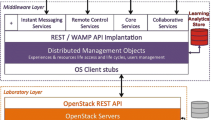Abstract
In this paper, we describe the design of the WebVPL system, a Webbased Virtual Programming Lab for on-line distance learning. The underlying setting is a collection of Lab server computers hosting education and programming software. Students use personal computers at home to access over the Internet one of the Lab servers, which performs functions to accommodate various requests from the student such as software usage. The lab servers can be located in different buildings and even at different campuses. WebVPL facilitates resource sharing among different schools and overcomes the limit of geographical distances. The design of the WebVPL system includes the user interface, agent-based client side functions, the structuring of Lab servers, the mechanisms to locate user requested software packages / services and to present various forms of data and information, and the interfaces to various education and programming software packages. We discuss various implementation issues and describe a prototype of the WebVPL.
Access this chapter
Tax calculation will be finalised at checkout
Purchases are for personal use only
Preview
Unable to display preview. Download preview PDF.
Similar content being viewed by others
References
Y. Amir, A. Peterson, and D. Shaw, “Seamlessly Selecting the Best Copy from Internet-Wide Replicated Web Servers”, Proc. 12th International Symposium on Distributed Computing (formerly WDAG), Andros, Greece, Sep. 1998.
M. Campione et al., "The Java Tutorial Continued", Addison-Wesley. 1999. (http://java.sun.com/docs/books/tutorial/)
S. Card, G. Robertson, and J. Mackinlay, “The information Visualizer, and Information Workspace”, Proc. Inte’l Conf. Human Factors in Computer Science, Boston, Mass. 1991. pp. 105–115.
V. Cardellini, M. Colajanni, and P.S. Yu, “Dynamic Load Balancing on Web-Server Systems”, IEEE Internet Computing, May–June 2000. pp. 28–39.
W.S. Chan, “Distributed Dynamic Load Balancing using Software mobile Agents”, Project Dissertaion (under supervision of J. Cao), Dept of Computing, Hong Kong Polytechnic University, May, 2000.
H.M. Deitel, P.J. Deitel, and T.R. Nieto, “Internet and World Wide Web: How to Program”, Prentice Hall, 2000.
J. Hardman and J. Wernecke, "The VRML 2.0 Handbook, Building Moving Worlds on the Web", Addision-Wesley. 1996.
B. Ibrahim, "Distance learning with the World-Wide Web", Proc. Int’l Conf. On Open and Distance Learning — Critical Success Factors, Oct. 1994. pp. 123–126.
B. Ibrahim, "Use of HTML Forms for Complex User Interfaces to Server-Side Applications", Int’l Journal of Human-Computer Studies (Special Issue on Innovative Applications of the World Wide Web), 46 (1997). pp. 761–771. (http://cuiwww.unige.ch/eao/www/Bertrand.html)
R. Khare and A. Rifkin, "XML: A Door to Automated Web Applications", IEEE Internet Computing, Vol. 1, No. 4, July–Aug. 1997. pp. 78–87.
D.B. Lange and M. Oshima, “Seven Good Reasons for Mobile Agents”, Communication of the ACM, Vol. 42, No. 3, March 1999. pp. 88–89.
S. Laurent, "XML A Primer" (2nd Edition), IDG Books Worldwide, Inc. 1999.
D.R. McIntyre and F.G. Wolff, "An Experiment with WWW Interactive Learning in University Education", Computers and Education, 31 (1998). pp. 255–264.
I. Nelson et al., "Eduction 2000: Implications of W3 Technology", Computers and Eduction, Vol. 26, No. 1–3, pp. 113–122.
P.-A. Queloz and C. Pellegrini, "Foreign Event Handlers to Maintain Information Consistency and System Adequacy", Proc. Workshop on Mobile Agnets in the Context of Competition and Cooperation, Autonomous Agents Conference, Seattle, USA, May 1999.
G.W. Rowe and P. Gregor, “A Computer Based Learning System for Teaching Computing: Implementation and Evaluation”, Computers and Education, 33 (1999). pp. 65–76.
A. Shabo, M. Guzdial. and J. Stasko, "An Apprenticeship-Based Multimedia Courseware for Computer Graphics Studies Provided on the World Wide Web", Computers and Education, Vol. 29, No. 2/3, pp. 103–116, 1997.
T.K. Shih et al., "An Adaptive Tutoring Machine Based on Web Learning Assessment", Proc. ICME 2000, IEEE International Conference on Multimedia and Expo, 2000. pp. 1667–1670.
K.M. Swigger et al., "The Virtual Collaborative University", Computers and Education, Vol. 29, No. 2/3, 1997. Pp. 55–61.
R.K. Thralls, “Building HTML Application Systems: Converting Existing MS-Windows Applications to HTML”, Proc. 2nd Int’l WWW Conference: Mosaic and the Web, Chicago, Oct. 1994. pp. 17–20. (http://www.ncsa.uiuc.edu/SDG/IT94/Proceedings/WebProd/thralls/WhitePaper.html).
WBT Systems, Topclass, (http://www.wbtsystems.com)
WebCT, Universal Learning Technology (http://www.webct.com)
Robert Ubell, "Engineers turn to e-learning", IEEE Spectrum Oct 2000. pp. 59–68.
WiredX, Jcraft (http://www.jcraft.com/wiredx)
C. Yoshikawa, B. Chun, and P. Eastham, “Using Smart Clients to Build Scalable Services”, Proc. USENIX’97. Sep. 1997.
Author information
Authors and Affiliations
Editor information
Editors and Affiliations
Rights and permissions
Copyright information
© 2002 Springer-Verlag Berlin Heidelberg
About this paper
Cite this paper
Cao, J., Chan, A., Cao, W., Yeung, C. (2002). Virtual Programming Lab for Online Distance Learning. In: Fong, J., Cheung, C.T., Leong, H.V., Li, Q. (eds) Advances in Web-Based Learning. ICWL 2002. Lecture Notes in Computer Science, vol 2436. Springer, Berlin, Heidelberg. https://doi.org/10.1007/3-540-45689-9_18
Download citation
DOI: https://doi.org/10.1007/3-540-45689-9_18
Published:
Publisher Name: Springer, Berlin, Heidelberg
Print ISBN: 978-3-540-44041-3
Online ISBN: 978-3-540-45689-6
eBook Packages: Springer Book Archive




